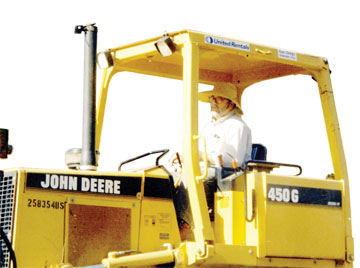Volume 29 · Number 2 · Winter 2012
Tractor time
Even an ecology student can dream of driving bulldozers.
It was all my mother's fault, really, for encouraging me to read. Libraries and books were a way of life when I was growing up. From our earliest days my brother and I would stagger home from the library each week with as many books as we could carry. One of my favorites, which I read again and again, was Stephen Meader's 1951 children's classic, Bulldozer. At the start of the story, Bill Crane finds an abandoned Caterpillar tractor in a pond, rebuilds it and then develops an earthmoving and excavating business. I loved the story, the theme of salvation and self-reliance — and especially the dozer.

My tractor dreams never died. When I got to UC Davis as an ecology graduate student, I signed up for the class, Ag Practices 49A Field Equipment Operation, which offered an interesting selection of tractors and equipment. A somewhat terrifying pedagogical approach — see one, do one, teach one — kept us on our toes because, after learning how to drive a beast, you had to teach the next student. Our lessons were controlled mayhem at times, but slow moving enough to give the instructor time to step in before buildings or fences were flattened.
My next opportunity for tractor driving came pulling hayrides around campus, a perk of being a residence hall advisor in the grad dorm. This led to many adventures as well, and I fondly remember the equipment maintenance staff and their unflappable attitudes. One night I returned from a hayride to Putah Creek and found the gate locked. I tried to turn the trailer around on the gravel road and quickly discovered that the trailer tongue was much weaker than the force required to spin the trailer. After bending the tongue about 20 degrees, I stopped and trudged back to the equipment lair, and was pleased to find someone working late. With no fuss or fanfare, he walked back with me, unlocked the gate and drove the tractor and trailer home for repair.
Another night found us out by Putah Creek again with a full load of cheerful graduate students. We took a hayride, enjoyed a campfire at the picnic ground, and then came back. As I slowly putted down the road, looking carefully ahead, I was shocked to suddenly feel a tap on my shoulder. One of the more "adventurous" students had walked down the trailer tongue to say hello. I stopped and gently advised everyone that, while impressive, "tongue walking" was ill advised. To discourage any repeats, I took off with a bit too much speed on a downhill stretch. I lightly touched the brakes — discovering the problem of braking a heavy load with a light tractor. Fortunately I managed to avoid a jackknife, and I don't think any of my passengers ever knew. Experience made me an ever more cautious driver on future events.
During my career as a restoration ecologist, I was more often repairing damage that vehicles had done to state or federal lands than I was creating roads or trails. But now and then, I got to drive a tractor — usually little four-wheel drive Kubotas and Fords, but sometimes a bigger dozer. I always looked forward to the days when I could fire up a tractor and go to work — just like Bill Crane.
Now that I'm retired, I still look for opportunities for recreational tillage. And as my wife would add, I have salvaged and repaired old trucks and rusty equipment. That poor little tractor in the field, it needs a new home. . . .
So parents, watch what books, videos or You Tube videos your kids are consuming. Fifty years from now they may still be shaping their behavior. And if they should make it toUC Davis, make sure they sign up for Ag Practices 49.
